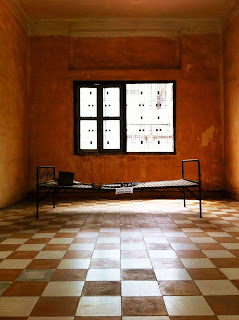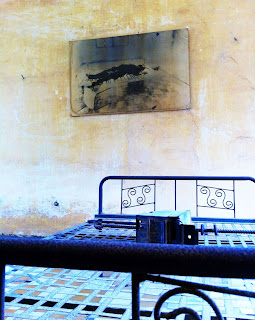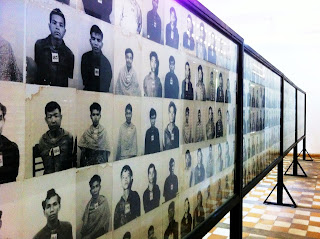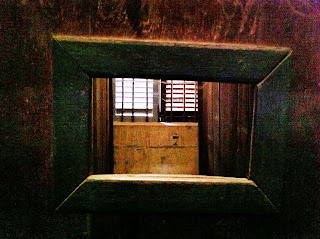 |
| The Killing Fields. Buddhist prayer bracelets left on bamboo fence surrounding a women and children's mass grave. The Killing Tree in the background. |
This isn't some morbid fascination in visiting haunted places with tortured souls. In fact, we were hesitant about going at all because we didn't know if we could handle the information. However, they have been preserved to reveal the horrific story of the Khmer Rouge past to the world with hopes of never repeating this dark history again.
Prior to our arrival in Cambodia, we did a lot of reading on the Khmer Rouge and the genocide that killed approximately 2 million or 25% of the country's population from 1975 to 1979. One of the most poignant books was the autobiography, Surviving the Killing Fields, by Dr. Haing S. Ngor. As a first-time actor, he actually won an Oscar for best-supporting actor for his role as Dith Pran in the movie, The Killing Fields.
 |
| Dr. Haing S. Ngor's autobiography. |
We encourage you to learn more about the crazed-paranoid leader, Pol Pot and his communist party who had a social engineering policy of exterminating any evidence of any culture, capitalism, and religion from the face of Cambodia in favor of a self-sufficient agrarian utopia. He succeeded in extermination but failed miserably in any sort of utopia. More like hell on earth is what they created.
Anyone that was a reminder of the former society (intellectuals, professionals, teachers, merchants, ethnic minorities, monks, even those wearing glasses because that indicated they could read and therefore, educated, etc.) were killed. Those suspected of spying for the CIA (they'd never even heard of the CIA, but that didn't matter) were tortured, forced to falsely confess names of friends and family who were "also CIA spies", and summarily executed. The worst torture was reserved for Khmer Rouge's own rank and file suspected of treason. Many also died from being worked to death in the rice fields, starvation, and disease.
A calculated, mass-murder of your own people is difficult to fathom. Yet, thanks to Khmer Rouge's own meticulous record-keeping and the lack of time in getting rid of the evidence when the Vietnamese liberation army drove them out, we were able to witness the remnants of this horror.
Choeung Ek Genocidal Center (The Killing Fields)
 |
| Buddhist stupa memorializing the 17,000 or so who were buried here in mass graves. 5000 skulls line the interior of this 8-story stupa. Killing Fields are to the right of the trees. |
Of the 20,000 mass graves scattered around the country, the most famous is the Killing Fields at Choeung Ek, approximately 15 km away from Phnom Penh. Prisoners (men, women, children, babies) from the Tuol Sleng S-21 prison were brought here, handcuffed, in trucks in the middle of the night to be executed and dumped into mass graves. Numbers vary but approximately 17,000 bodies were buried here in over 120 shallow graves. ~8000 skeletal remains have been recovered but many still lay buried in visible graves. After a strong rain, it's typical for bone fragments, teeth, and pieces of clothing to surface. An 8-story Buddhist stupa was recently built as a memorial which houses the skulls.
 |
| Layout of the Choeung Ek Killing Fields. |
 |
| Sites of other mass graves and former prisons in Cambodia. |
For $5/pp admission, a well-done self-guided audio tour of the grounds, stupa, and museum was included. We hope the victims are now resting in peace, undisturbed at this very serene and beautiful setting that was once the killing fields.
 |
| The dips in the earth are unexcavated mass graves. There are ~120 of these here. |
 |
| The bark of a palm sugar tree is jagged and sharp. To save bullets, throats were cut using the bark as one method of killing. |
 |
| One of the larger shallow mass graves unearthed. |
 |
| Buddhist prayer bracelets on bamboo fencing surrounding a mass headless grave site. |
 |
| Most disturbing and sick of all. The Killing Tree where the soldiers bashed in the heads of small children and babies, then dumped them in the mass grave right next to the tree. |
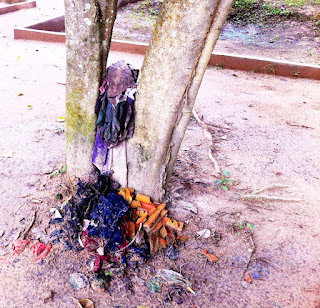 |
| Fragments of clothing continue to surface from the grave sites. |
 |
| A large speaker hung from this tree that played communist propaganda and music to drown out the moans and screams from neighboring farmers. |
 |
| Entrance to the stupa. |
 |
| Origami cranes donated by the Junior League Red Cross of Japan! |
 |
| 5000 skulls lie in rest inside the 8-story stupa. |
As a side note, be prepared for the 40 minute tuk tuk drive each way to/from Phnom Penh. At this time, part of this very busy road is unpaved. To avoid being suffocated by exhaust fumes and rocks flying in your face, remember to bring something to cover your mouth and eyes! Click here to watch our 2.5 minute YouTube video of our ride.
Tuol Sleng Genocide Museum (Office S-21 Prison)
 |
| Tombs for the last 14 victims who died in prison, discovered rotting, still tied to their beds after being mercilessly tortured in Bldg. A. |
There's a documentary created in 2003 available via Netflix titled S-21: The Khmer Rouge Killing Machine that may be of interest. Directed by Rithy Pahn (a survivor), two other survivors visit the prison and meet their captors and interrogators.
The Vietnamese tried to leave Building A "as-is", as authentic as they found it. The floors have been cleaned up (yet obvious stains remain) but the bed, shackles, and torture devices have been left in each of the rooms with a photograph by the Vietnamese combat photographer on how they found the victims. This was the most haunting part of the museum.
Let's just say, the Khmer Rouge were meticulous in their documentation. They took a detailed biography, photograph, and confession of almost every prisoner that came through the doors of S-21. They even hired some prisoners who were artists to paint scenes of torture taking place. These were all displayed in Building B.
 |
| Building B. Note the gallows where they hung prisons from their arms tied to their backs. |
 |
| Water boarding torture device. |
 |
| The 7 survivors. |
 |
| "Duch", chief of security at prison's photo vandalized. |
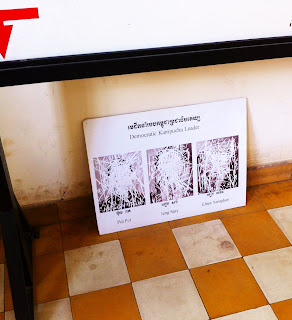 |
| Photo of the 3 Khmer Rouge leaders also vandalized. Interesting that the photo has been taken down from the wall and set on the floor... |
 |
| More vandalism to photos of war criminals during trials. |
 |
| Chalkboard. After all, it was a former high school. The long plywood board next to the chalkboard could've been the official backdrop for many of the mug shots. |








